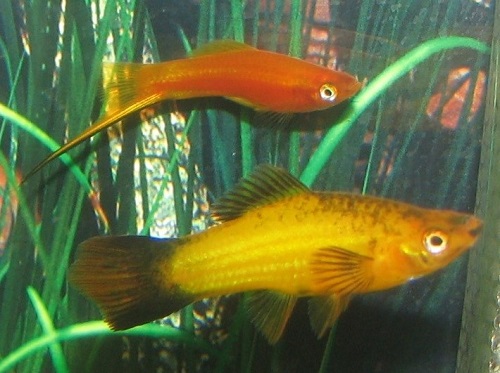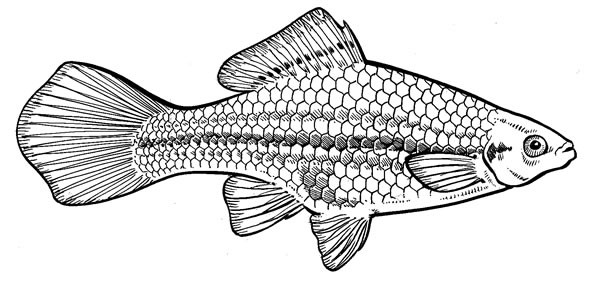Swordtail
Male and female swordtail
© Trisha Shears, Creative Commons
© Trisha Shears, Creative Commons
Female swordtail illustration
© Queensland Government
© Queensland Government
Male swordtail illustration
© Queensland Government
© Queensland Government
Swordtails are popular aquarium fish but have become a pest in Queensland waterways due to people releasing them. You may keep swordtails in an aquarium, but don't release them into local rivers and creeks and avoid keeping them in backyard ponds. You must not use them as bait. If you catch them in the wild, humanely kill them and don't return them to the water.
Scientific name
Xiphophorus hellerii
Description
- Stout-bodied fish.
- Look like platies, except for sword-like tail extending from the bottom of the caudal (tail) fin of males.
- Males grow to 14cm.
- Females grow to 16cm.
- Males can be distinguished by their long sword-like tail.
- Wild-caught fish usually look pale brown, with a brighter green back and silver underside.
- Aquarium species vary in colour.
Habitat
- Tropical fish that can survive in fresh and brackish water.
- Usually found in rapidly flowing streams and rivers.
- Prefers heavily vegetated habitats.
- Can survive in degraded waterways, unlike native fish.
Distribution
- Native to Central America.
- Widely introduced to many areas including Australia, Hawaii, the United States, Papua New Guinea, Israel, Puerto Rico, Sri Lanka, South Africa, Columbia, Bahamas, Fiji, Guam, Hong Kong and New Zealand.
- Established in Queensland in some coastal drainages, particularly in urban streams around Brisbane.
Life cycle
Breeding
- Gives birth to live young.
- Produces 20–200 young after a gestation period of 24–30 days.
- Sexually mature at 8–12 months.
- Can undergo sex reversal under some environmental conditions.
Diet
- Omnivorous.
- Feeds on worms, crustaceans, insects and plant matter.
Impacts
- Many countries report adverse ecological impacts after introducing swordtails.
- Competes with native fish for food and space.
- Dominates waterways due to high ability to reproduce and survive in habitats that are not suitable for native fish.
Control
- If you catch swordtails in the wild, humanely kill them and do not return them to the water. Report all invasive fish captures through our online reporting form. Take photos, if possible.
Legal requirements
- Under the Biosecurity Act 2014 everyone has a general biosecurity obligation (GBO) to take reasonable and practical steps to minimise the risks associated with spreading or introducing pest fish. This includes any fish that is not native to Australia.
- To ensure you have met your GBO
- don't stock non-native fish in outdoor ponds
- don't release aquarium fish or aquarium water into waterways
- do what you reasonably can to stop a potential biosecurity threat from spreading. This could include reporting the issue to Biosecurity Queensland.
Further information
- Biosecurity Act 2014 and Biosecurity Regulation 2016
- Grant, EM 1997, Grant's guide to fishes, EM Grant Pty Ltd, Brisbane
- Managing the biosecurity risk of ornamental aquarium fish in Queensland fact sheet (PDF, 2.1MB)
- FishBase—a global information system on fishes


